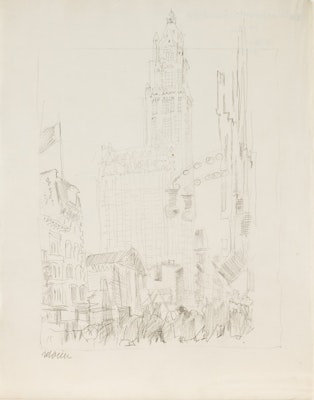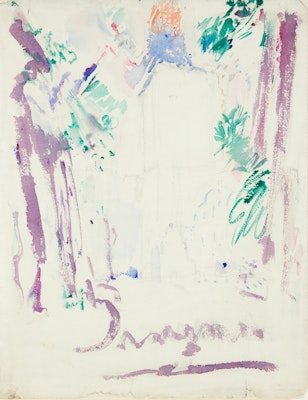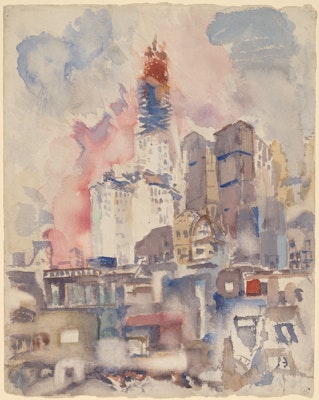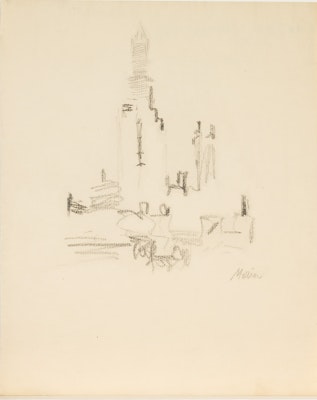Woolworth Building
When Marin returned to the United States from Europe in 1909, he found New York City rapidly transforming. The tall buildings known as skyscrapers rose ever higher. The most famous skyscraper of that early era was the Woolworth Building, completed in 1913. Designed by architect Cass Gilbert to house the corporate headquarters for the F. W. Woolworth Company, the neo-gothic skyscraper at 233 Broadway Avenue was, at 792 feet, the world’s tallest building until it was surpassed by the Empire State Building in 1931. The grand scale of the building, combined with its homage to gothic style, led to its nickname, “the cathedral of commerce.” Marin’s sketches of the Woolworth Building laid the foundations for his watercolors and etchings of the famous building.
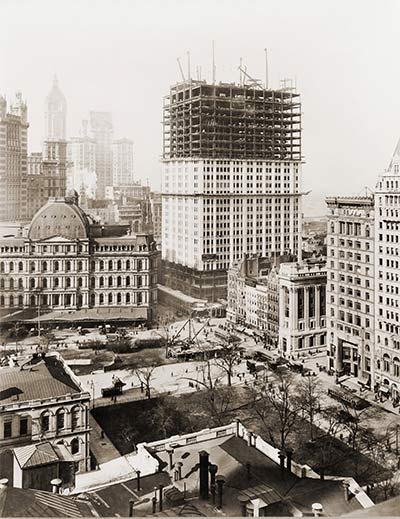
The whole city is alive — buildings, people, all are alive — and the more they move me the more I feel them to be alive. It is this moving of me that I try to express.
John Marin, Camera Work, July 1913, 18
City Hall Park
The Woolworth Building was in an area that Marin loved to depict: City Hall Park. The open land of the park afforded the artist the ability, rare in Manhattan, to stand back enough to get good views of tall structures rather than having to look up at them towering directly above him or to see them lined up behind other structures farther down a street. The structures around City Hall Park became emblems of his modernism – the Brooklyn Bridge, in easy walking distance from the park; St. Paul’s Chapel, just down Broadway; City Hall itself; and two buildings that were under construction simultaneously during an exciting stretch of 1912 and early 1913 — the Municipal Building, and the Woolworth Building.
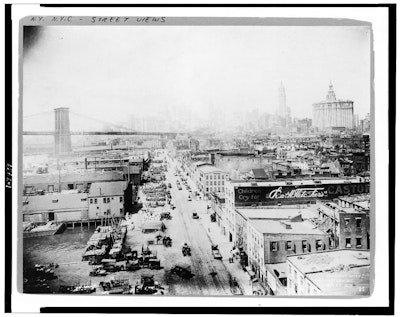
South Street, N.Y
American Studio, South Street, N. Y., circa 1917, photograph, Library of Congress, LC-USZ62-107489, https://lccn.loc.gov/93504630. The Brooklyn Bridge is at the left, close to City Hall Park, where the Woolworth Building and the Municipal Building stand at the right.
Some of Marin’s greatest images of the Woolworth Building were made in the form of etchings. In Woolworth Building, No. 1, the artist inked each print from the copper plate differently. Each image is a unique interpretation of the image exploring the vast energy of the towering skyscraper.
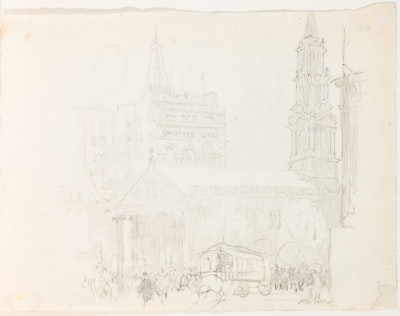
St. Paul’s Chapel, Manhattan
John Marin, St. Paul’s Chapel, Manhattan, circa 1910, graphite on paper, 8 ½ × 11 ½ in. (21.59 × 29.21 cm.), Arkansas Arts Center Foundation Collection: Gift of Norma B. Marin, New York, New York 2013.018.265
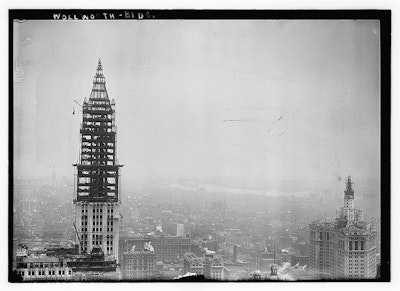
Woolworth Building
Bain News Service, Woolworth Building, circa 1912, glass plate negative, 5 × 7 inches (12.5 × 17.78 cm.), © George Grantham Baine Collection, Library of Congress. At the left is the Woolworth building and at the right is the Municipal Building.
I have just started Some Downtown stuff and to pile these great houses one upon another with paint as they do pile themselves up there so beautiful, so fantastic.
John Marin, notes from 1911
The first style comprised detailed, traditional architectural renderings in traditional linear perspective.
Works in the second style were roughly sketched renderings giving more stress to textures.

Woolworth Building under Construction
John Marin, Woolworth Building under Construction, 1912, graphite on paper, 10 × 8 in. (25.4 × 20.32 cm.), Arkansas Arts Center Foundation Collection: Gift of Norma B. Marin, New York, New York. 2013.018.278.
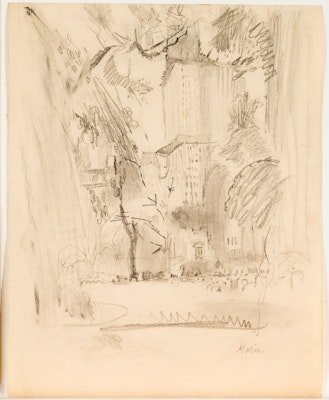
Woolworth Building under Construction
John Marin, Woolworth Building under Construction, 1912, graphite on paper, 10 × 8 in. (25.4 × 20.32 cm.), Arkansas Arts Center Foundation Collection: Gift of Norma B. Marin, New York, New York. 2013.018.288.
Works in the third style were fragmented, exaggerated views in which he felt free to distort perspective and structure for modernist expression.
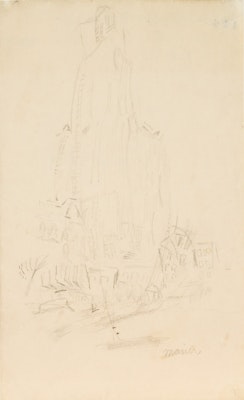
Woolworth Building, Manhattan(1912–1914)
John Marin, Woolworth Building, Manhattan, 1912-1914, graphite on paper, 8 × 4 ⅞ in. (20.32 × 12.38 cm.), Arkansas Arts Center Foundation Collection: Gift of Norma B. Marin, New York, New York. 2013.018.258.
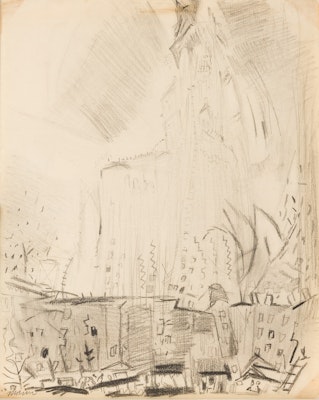
Untitled (Woolworth Building)
John Marin, Untitled (Woolworth Building), 1912–1913, graphite on paper, 9 ½ × 7 ⅜ inches (24.13 × 18.73 cm.), Arkansas Arts Center Foundation Collection: Purchase. 1979.006.001.
They — the drawings — were mostly made in a series of wanderings around about my City — New York — with pencil and paper in — short hand - writings — as it were — Swiftly put down.
John Marin, unpublished notes
Marin completed a series of modernist, cubist-inspired watercolors of the Woolworth Building in 1911, 1912 and 1913.
All of these images express the implied energy and motion Marin felt in the towering structure.
In 1913, Marin’s dealer, mentor, and friend Alfred Stieglitz first exhibited some of the completed watercolors of the Woolworth Building and other subjects from January 20 to February 15, 1912, at the Little Galleries of the Photo-Secession, known as 291 for its address on Fifth Avenue.
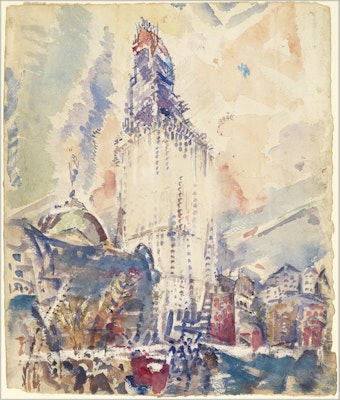
Woolworth Building(No. 28)
John Marin, Woolworth Building, No. 28, 1912, watercolor and graphite on paper, 18 ½ × 15 9/16 inches (46.99 × 39.53 cm.), National Gallery of Art, Washington, D.C., Gift of Eugene and Agnes E. Meyer, 1967.13.8, SR.12.66. This is one of the watercolors shown at 291 Gallery and then at the Armory Show in 1913.
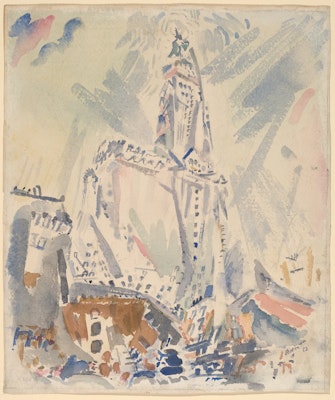
Woolworth Building(No. 31)
John Marin, Woolworth Building, No. 31, 1912, watercolor and graphite on paper, 18 ½ × 15 11/16 inches (21.59 × 39.85 cm.), National Gallery of Art, Washington, D.C., Gift of Eugene and Agnes E. Meyer, 1967.13.9, SR.12.68. This is one of the watercolors shown at 291 Gallery and then at the Armory Show in 1913.
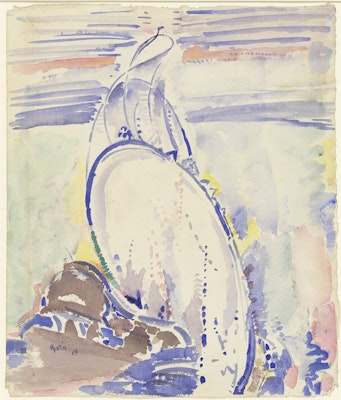
Woolworth Building(No. 32)
John Marin, Woolworth Building, No. 32, 1913, watercolor and graphite on paper, 18 5/16 × 15 ⅝ inches (46.51 × 39.69 cm.), National Gallery of Art, Washington, D.C., Gift of Eugene and Agnes E. Meyer, 1967.13.11.a, SR.12.69. This is one of the watercolors shown at 291 Gallery and then at the Armory Show in 1913.
Marin’s graphite drawings of the Municipal Building and the Woolworth Building and other structures around City Hall Park were rendered in three basic styles that he deployed for different purposes.
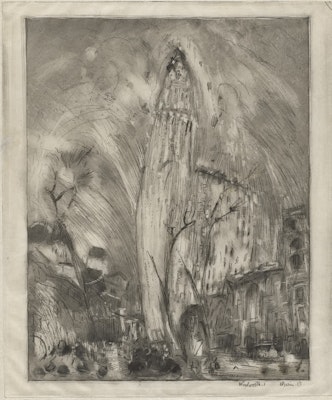
Woolworth Building(No. 1)
John Marin, Woolworth Building, No. 1, 1913, etching with unique inking, image: 10 ⅞ × 8 ⅜ inches (27.7 × 21.3 cm.), plate: 11 ⅞ × 9 ⅞ inches (30.1 × 25.1 cm.), sheet: 15 9/16 × 11 ⅝ inches (39.6 × 29.5 cm.), Philadelphia Museum of Art, The J. Wolfe Golden and Celeste Golden Collection of Marin Etchings, 1969, 1969-81-86, CZ.113, Copyright: © Estate of John Marin / Artists Rights Society (ARS), New York.
The Woolworth Building continued to be a favorite subject of Marin’s long after it was completed.
